National Archives Australia Project Governance Plan Report
VerifiedAdded on 2021/04/17
|19
|3391
|135
Report
AI Summary
This report presents a comprehensive governance plan for the National Archives of Australia (NAA) project, focusing on the technical upgrade of their website. It begins with an overview of the client, NAA, and defines project governance, outlining the scope of the document. The report details the governance framework, aligning project portfolios with organizational goals and strategies, and describes stakeholder engagement strategies. It includes organizational and project structure charts, identifies the steering committee, and defines roles, responsibilities, and delegations for key team members. Project governance reporting requirements are listed, and the risk and issue escalation process is explained, providing examples of risk identification and resolution. The report includes tables for document revision history, table of contents, project structure, project governance roles, and risk escalation to enhance clarity and understanding of the project's governance.
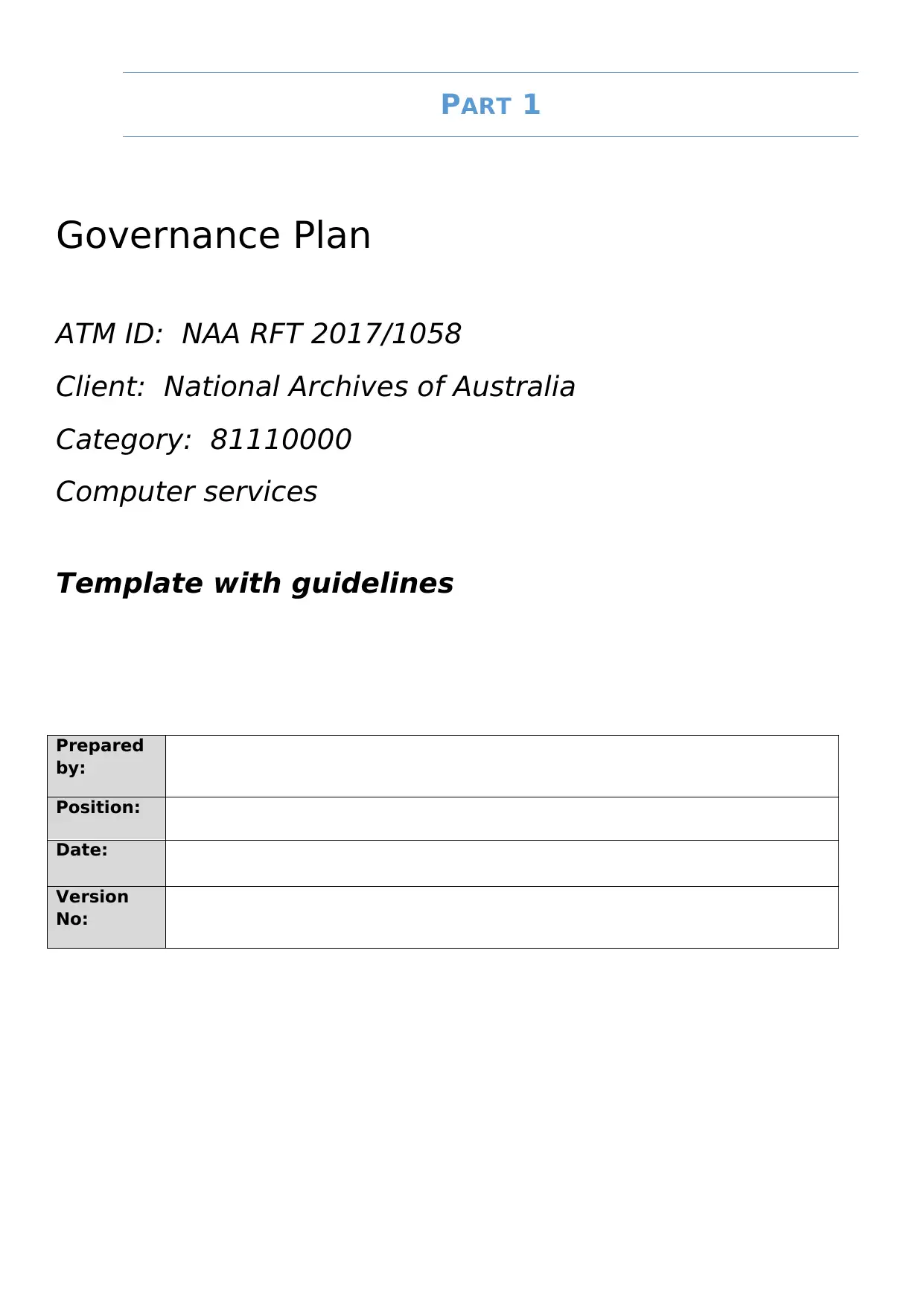
PART 1
Governance Plan
ATM ID: NAA RFT 2017/1058
Client: National Archives of Australia
Category: 81110000
Computer services
Template with guidelines
Prepared
by:
Position:
Date:
Version
No:
Governance Plan
ATM ID: NAA RFT 2017/1058
Client: National Archives of Australia
Category: 81110000
Computer services
Template with guidelines
Prepared
by:
Position:
Date:
Version
No:
Paraphrase This Document
Need a fresh take? Get an instant paraphrase of this document with our AI Paraphraser

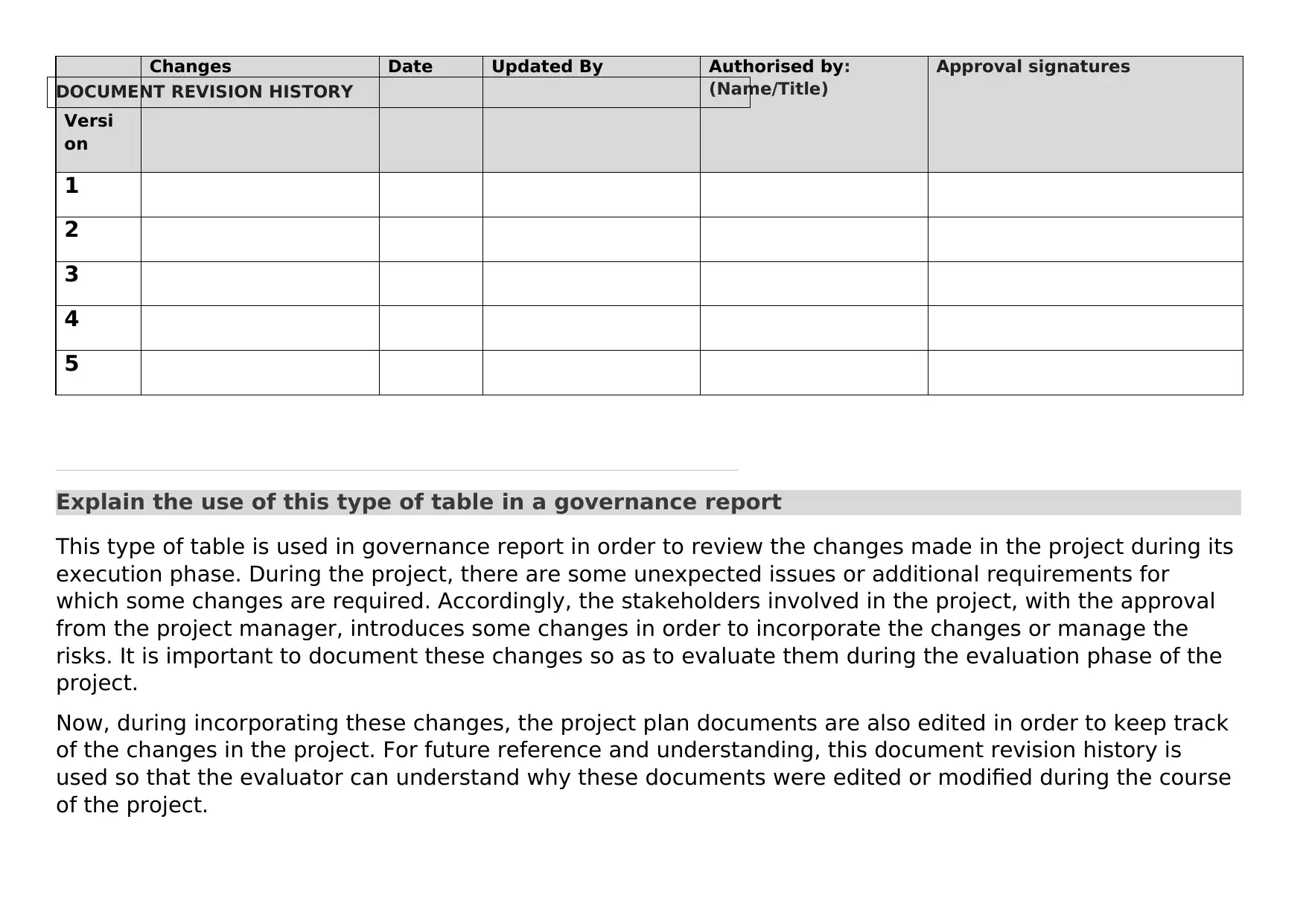
Versi
on
Changes Date Updated By Authorised by:
(Name/Title)
Approval signatures
1
2
3
4
5
Explain the use of this type of table in a governance report
This type of table is used in governance report in order to review the changes made in the project during its
execution phase. During the project, there are some unexpected issues or additional requirements for
which some changes are required. Accordingly, the stakeholders involved in the project, with the approval
from the project manager, introduces some changes in order to incorporate the changes or manage the
risks. It is important to document these changes so as to evaluate them during the evaluation phase of the
project.
Now, during incorporating these changes, the project plan documents are also edited in order to keep track
of the changes in the project. For future reference and understanding, this document revision history is
used so that the evaluator can understand why these documents were edited or modified during the course
of the project.
DOCUMENT REVISION HISTORY
on
Changes Date Updated By Authorised by:
(Name/Title)
Approval signatures
1
2
3
4
5
Explain the use of this type of table in a governance report
This type of table is used in governance report in order to review the changes made in the project during its
execution phase. During the project, there are some unexpected issues or additional requirements for
which some changes are required. Accordingly, the stakeholders involved in the project, with the approval
from the project manager, introduces some changes in order to incorporate the changes or manage the
risks. It is important to document these changes so as to evaluate them during the evaluation phase of the
project.
Now, during incorporating these changes, the project plan documents are also edited in order to keep track
of the changes in the project. For future reference and understanding, this document revision history is
used so that the evaluator can understand why these documents were edited or modified during the course
of the project.
DOCUMENT REVISION HISTORY
⊘ This is a preview!⊘
Do you want full access?
Subscribe today to unlock all pages.

Trusted by 1+ million students worldwide
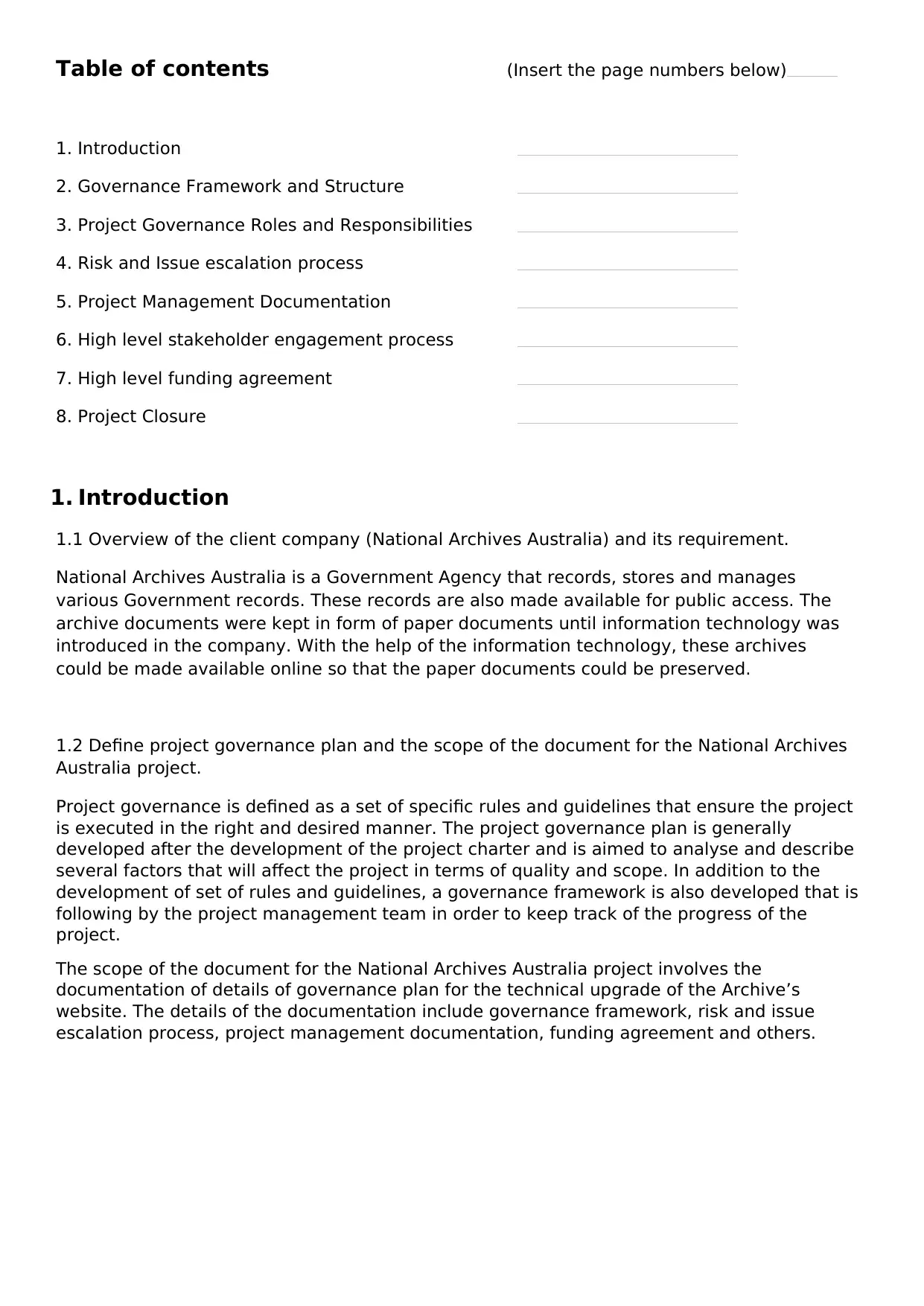
Table of contents (Insert the page numbers below)
1. Introduction
2. Governance Framework and Structure
3. Project Governance Roles and Responsibilities
4. Risk and Issue escalation process
5. Project Management Documentation
6. High level stakeholder engagement process
7. High level funding agreement
8. Project Closure
1. Introduction
1.1 Overview of the client company (National Archives Australia) and its requirement.
National Archives Australia is a Government Agency that records, stores and manages
various Government records. These records are also made available for public access. The
archive documents were kept in form of paper documents until information technology was
introduced in the company. With the help of the information technology, these archives
could be made available online so that the paper documents could be preserved.
1.2 Define project governance plan and the scope of the document for the National Archives
Australia project.
Project governance is defined as a set of specific rules and guidelines that ensure the project
is executed in the right and desired manner. The project governance plan is generally
developed after the development of the project charter and is aimed to analyse and describe
several factors that will affect the project in terms of quality and scope. In addition to the
development of set of rules and guidelines, a governance framework is also developed that is
following by the project management team in order to keep track of the progress of the
project.
The scope of the document for the National Archives Australia project involves the
documentation of details of governance plan for the technical upgrade of the Archive’s
website. The details of the documentation include governance framework, risk and issue
escalation process, project management documentation, funding agreement and others.
1. Introduction
2. Governance Framework and Structure
3. Project Governance Roles and Responsibilities
4. Risk and Issue escalation process
5. Project Management Documentation
6. High level stakeholder engagement process
7. High level funding agreement
8. Project Closure
1. Introduction
1.1 Overview of the client company (National Archives Australia) and its requirement.
National Archives Australia is a Government Agency that records, stores and manages
various Government records. These records are also made available for public access. The
archive documents were kept in form of paper documents until information technology was
introduced in the company. With the help of the information technology, these archives
could be made available online so that the paper documents could be preserved.
1.2 Define project governance plan and the scope of the document for the National Archives
Australia project.
Project governance is defined as a set of specific rules and guidelines that ensure the project
is executed in the right and desired manner. The project governance plan is generally
developed after the development of the project charter and is aimed to analyse and describe
several factors that will affect the project in terms of quality and scope. In addition to the
development of set of rules and guidelines, a governance framework is also developed that is
following by the project management team in order to keep track of the progress of the
project.
The scope of the document for the National Archives Australia project involves the
documentation of details of governance plan for the technical upgrade of the Archive’s
website. The details of the documentation include governance framework, risk and issue
escalation process, project management documentation, funding agreement and others.
Paraphrase This Document
Need a fresh take? Get an instant paraphrase of this document with our AI Paraphraser
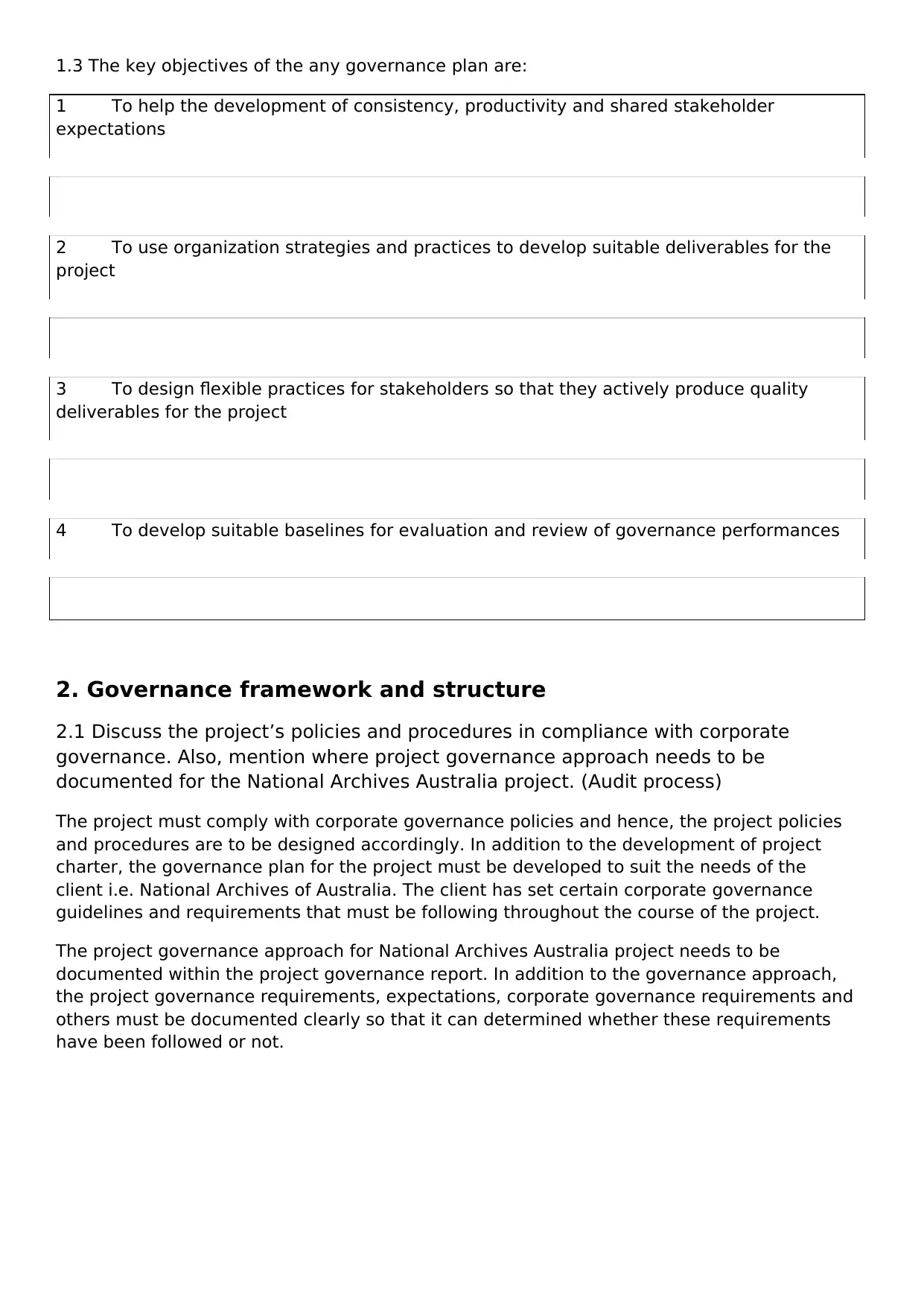
1.3 The key objectives of the any governance plan are:
1 To help the development of consistency, productivity and shared stakeholder
expectations
2 To use organization strategies and practices to develop suitable deliverables for the
project
3 To design flexible practices for stakeholders so that they actively produce quality
deliverables for the project
4 To develop suitable baselines for evaluation and review of governance performances
2. Governance framework and structure
2.1 Discuss the project’s policies and procedures in compliance with corporate
governance. Also, mention where project governance approach needs to be
documented for the National Archives Australia project. (Audit process)
The project must comply with corporate governance policies and hence, the project policies
and procedures are to be designed accordingly. In addition to the development of project
charter, the governance plan for the project must be developed to suit the needs of the
client i.e. National Archives of Australia. The client has set certain corporate governance
guidelines and requirements that must be following throughout the course of the project.
The project governance approach for National Archives Australia project needs to be
documented within the project governance report. In addition to the governance approach,
the project governance requirements, expectations, corporate governance requirements and
others must be documented clearly so that it can determined whether these requirements
have been followed or not.
1 To help the development of consistency, productivity and shared stakeholder
expectations
2 To use organization strategies and practices to develop suitable deliverables for the
project
3 To design flexible practices for stakeholders so that they actively produce quality
deliverables for the project
4 To develop suitable baselines for evaluation and review of governance performances
2. Governance framework and structure
2.1 Discuss the project’s policies and procedures in compliance with corporate
governance. Also, mention where project governance approach needs to be
documented for the National Archives Australia project. (Audit process)
The project must comply with corporate governance policies and hence, the project policies
and procedures are to be designed accordingly. In addition to the development of project
charter, the governance plan for the project must be developed to suit the needs of the
client i.e. National Archives of Australia. The client has set certain corporate governance
guidelines and requirements that must be following throughout the course of the project.
The project governance approach for National Archives Australia project needs to be
documented within the project governance report. In addition to the governance approach,
the project governance requirements, expectations, corporate governance requirements and
others must be documented clearly so that it can determined whether these requirements
have been followed or not.
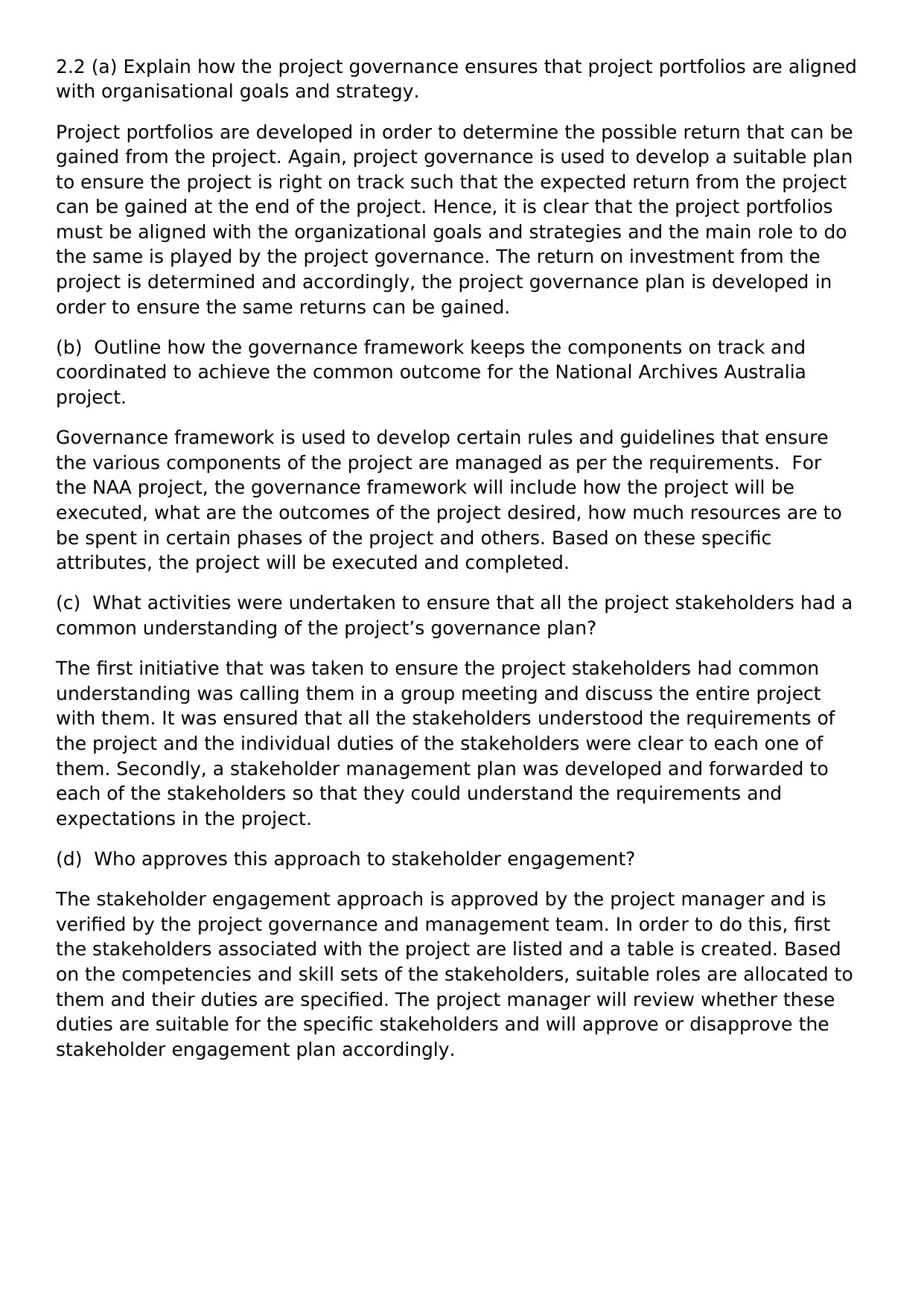
2.2 (a) Explain how the project governance ensures that project portfolios are aligned
with organisational goals and strategy.
Project portfolios are developed in order to determine the possible return that can be
gained from the project. Again, project governance is used to develop a suitable plan
to ensure the project is right on track such that the expected return from the project
can be gained at the end of the project. Hence, it is clear that the project portfolios
must be aligned with the organizational goals and strategies and the main role to do
the same is played by the project governance. The return on investment from the
project is determined and accordingly, the project governance plan is developed in
order to ensure the same returns can be gained.
(b) Outline how the governance framework keeps the components on track and
coordinated to achieve the common outcome for the National Archives Australia
project.
Governance framework is used to develop certain rules and guidelines that ensure
the various components of the project are managed as per the requirements. For
the NAA project, the governance framework will include how the project will be
executed, what are the outcomes of the project desired, how much resources are to
be spent in certain phases of the project and others. Based on these specific
attributes, the project will be executed and completed.
(c) What activities were undertaken to ensure that all the project stakeholders had a
common understanding of the project’s governance plan?
The first initiative that was taken to ensure the project stakeholders had common
understanding was calling them in a group meeting and discuss the entire project
with them. It was ensured that all the stakeholders understood the requirements of
the project and the individual duties of the stakeholders were clear to each one of
them. Secondly, a stakeholder management plan was developed and forwarded to
each of the stakeholders so that they could understand the requirements and
expectations in the project.
(d) Who approves this approach to stakeholder engagement?
The stakeholder engagement approach is approved by the project manager and is
verified by the project governance and management team. In order to do this, first
the stakeholders associated with the project are listed and a table is created. Based
on the competencies and skill sets of the stakeholders, suitable roles are allocated to
them and their duties are specified. The project manager will review whether these
duties are suitable for the specific stakeholders and will approve or disapprove the
stakeholder engagement plan accordingly.
with organisational goals and strategy.
Project portfolios are developed in order to determine the possible return that can be
gained from the project. Again, project governance is used to develop a suitable plan
to ensure the project is right on track such that the expected return from the project
can be gained at the end of the project. Hence, it is clear that the project portfolios
must be aligned with the organizational goals and strategies and the main role to do
the same is played by the project governance. The return on investment from the
project is determined and accordingly, the project governance plan is developed in
order to ensure the same returns can be gained.
(b) Outline how the governance framework keeps the components on track and
coordinated to achieve the common outcome for the National Archives Australia
project.
Governance framework is used to develop certain rules and guidelines that ensure
the various components of the project are managed as per the requirements. For
the NAA project, the governance framework will include how the project will be
executed, what are the outcomes of the project desired, how much resources are to
be spent in certain phases of the project and others. Based on these specific
attributes, the project will be executed and completed.
(c) What activities were undertaken to ensure that all the project stakeholders had a
common understanding of the project’s governance plan?
The first initiative that was taken to ensure the project stakeholders had common
understanding was calling them in a group meeting and discuss the entire project
with them. It was ensured that all the stakeholders understood the requirements of
the project and the individual duties of the stakeholders were clear to each one of
them. Secondly, a stakeholder management plan was developed and forwarded to
each of the stakeholders so that they could understand the requirements and
expectations in the project.
(d) Who approves this approach to stakeholder engagement?
The stakeholder engagement approach is approved by the project manager and is
verified by the project governance and management team. In order to do this, first
the stakeholders associated with the project are listed and a table is created. Based
on the competencies and skill sets of the stakeholders, suitable roles are allocated to
them and their duties are specified. The project manager will review whether these
duties are suitable for the specific stakeholders and will approve or disapprove the
stakeholder engagement plan accordingly.
⊘ This is a preview!⊘
Do you want full access?
Subscribe today to unlock all pages.

Trusted by 1+ million students worldwide
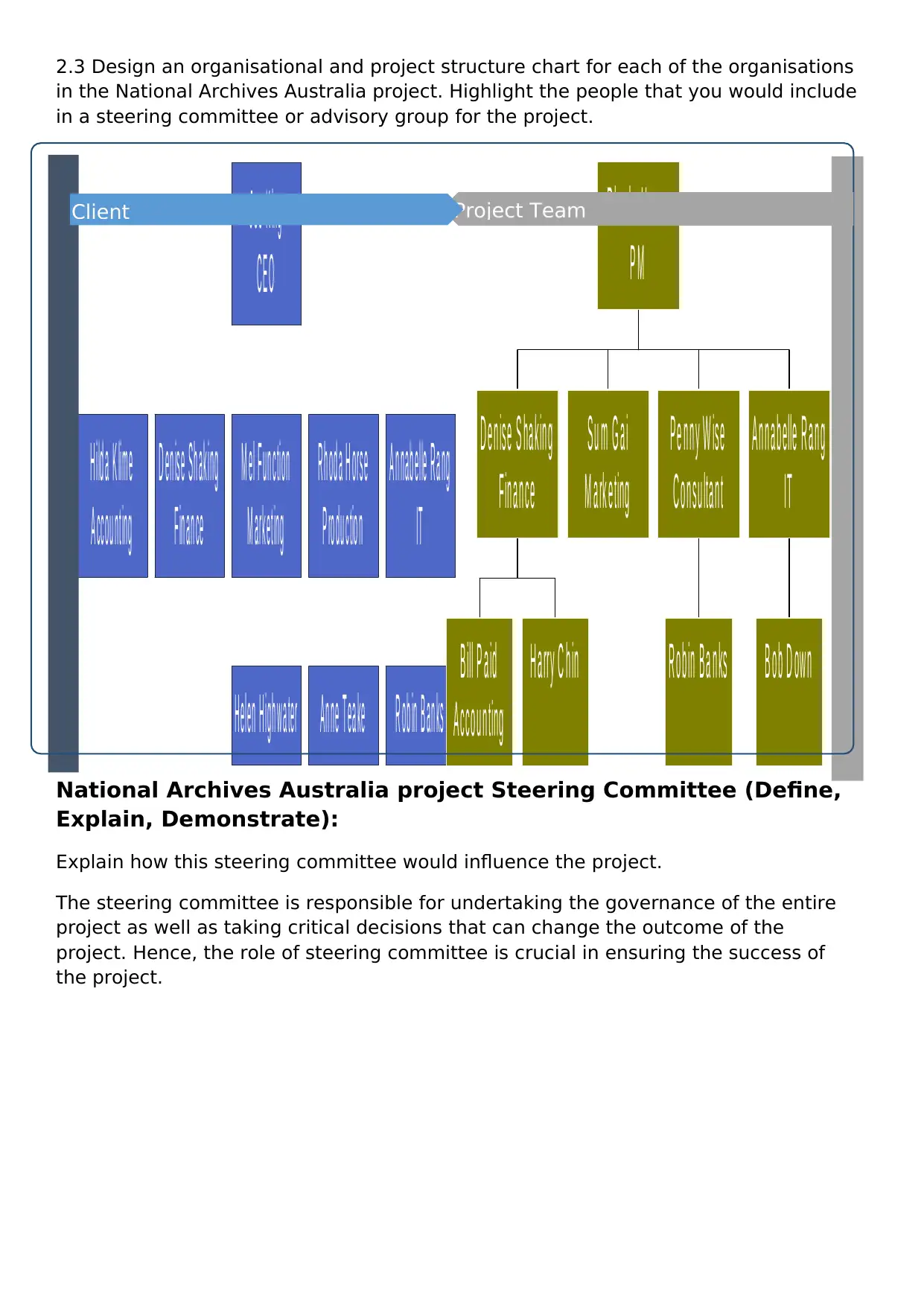
H ild a K lim e
A c co u n tin g
D e n ise S h a k in g
F in a n ce
M e l F u n c tio n
M a rk e tin g
H e le n H ig h w a ter A n n e T e a ke R o b in B a n ks
R h o d a H o rse
P ro d u c tio n
A n n a b e lle R a n g
IT
J o e K in g
C E O
B ill P a id
A c co u n tin g
H a rry C h in
D e n ise S h a k in g
F in a n ce
S u m G a i
M a rk e tin g
R o b in B a n ks
P e n n y W ise
C o n su lta n t
B o b D o w n
A n n a b e lle R a n g
IT
R h o d a H o rse
P M
2.3 Design an organisational and project structure chart for each of the organisations
in the National Archives Australia project. Highlight the people that you would include
in a steering committee or advisory group for the project.
National Archives Australia project Steering Committee (Define,
Explain, Demonstrate):
Explain how this steering committee would influence the project.
The steering committee is responsible for undertaking the governance of the entire
project as well as taking critical decisions that can change the outcome of the
project. Hence, the role of steering committee is crucial in ensuring the success of
the project.
Project TeamClient
A c co u n tin g
D e n ise S h a k in g
F in a n ce
M e l F u n c tio n
M a rk e tin g
H e le n H ig h w a ter A n n e T e a ke R o b in B a n ks
R h o d a H o rse
P ro d u c tio n
A n n a b e lle R a n g
IT
J o e K in g
C E O
B ill P a id
A c co u n tin g
H a rry C h in
D e n ise S h a k in g
F in a n ce
S u m G a i
M a rk e tin g
R o b in B a n ks
P e n n y W ise
C o n su lta n t
B o b D o w n
A n n a b e lle R a n g
IT
R h o d a H o rse
P M
2.3 Design an organisational and project structure chart for each of the organisations
in the National Archives Australia project. Highlight the people that you would include
in a steering committee or advisory group for the project.
National Archives Australia project Steering Committee (Define,
Explain, Demonstrate):
Explain how this steering committee would influence the project.
The steering committee is responsible for undertaking the governance of the entire
project as well as taking critical decisions that can change the outcome of the
project. Hence, the role of steering committee is crucial in ensuring the success of
the project.
Project TeamClient
Paraphrase This Document
Need a fresh take? Get an instant paraphrase of this document with our AI Paraphraser

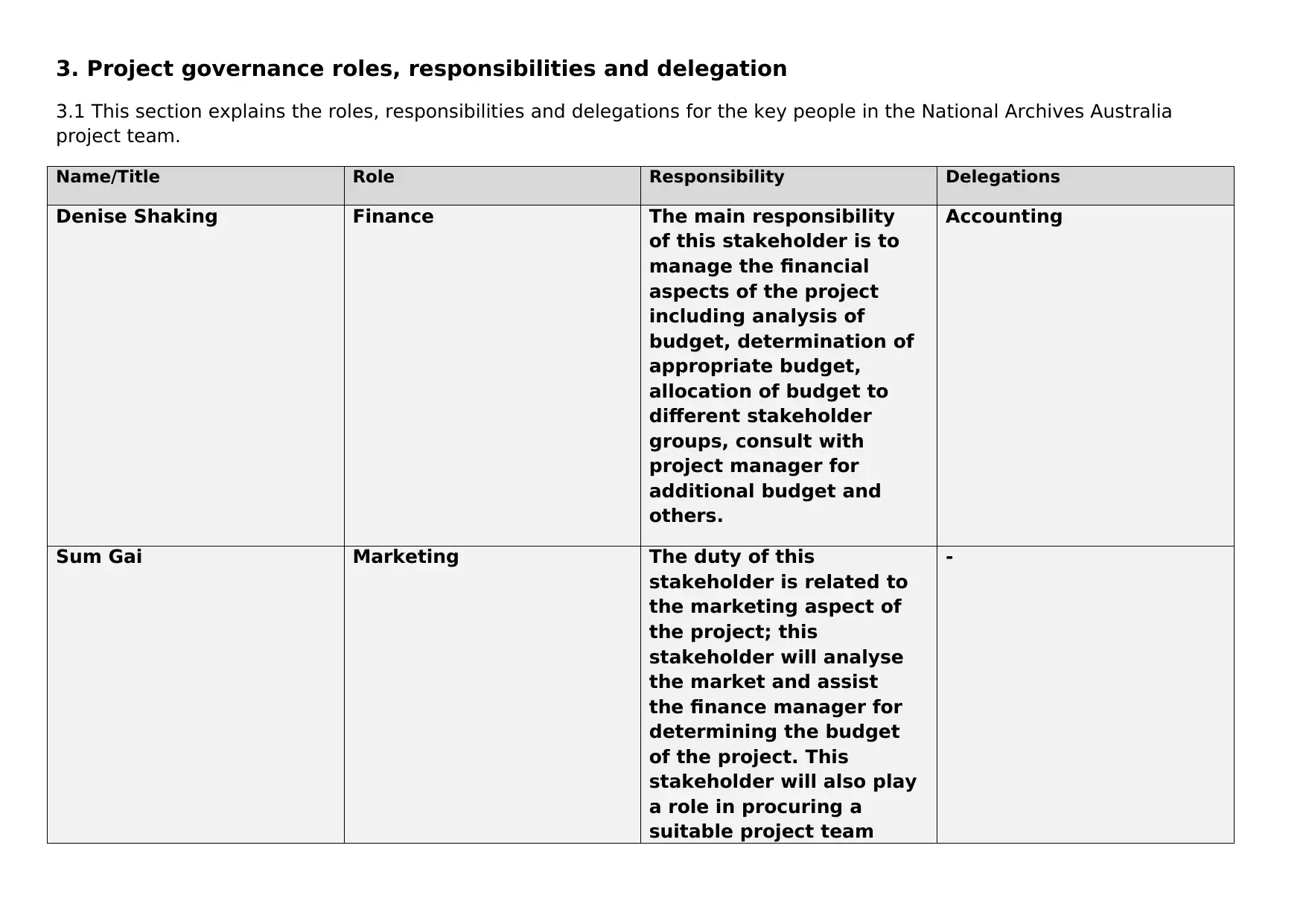
3. Project governance roles, responsibilities and delegation
3.1 This section explains the roles, responsibilities and delegations for the key people in the National Archives Australia
project team.
Name/Title Role Responsibility Delegations
Denise Shaking Finance The main responsibility
of this stakeholder is to
manage the financial
aspects of the project
including analysis of
budget, determination of
appropriate budget,
allocation of budget to
different stakeholder
groups, consult with
project manager for
additional budget and
others.
Accounting
Sum Gai Marketing The duty of this
stakeholder is related to
the marketing aspect of
the project; this
stakeholder will analyse
the market and assist
the finance manager for
determining the budget
of the project. This
stakeholder will also play
a role in procuring a
suitable project team
-
3.1 This section explains the roles, responsibilities and delegations for the key people in the National Archives Australia
project team.
Name/Title Role Responsibility Delegations
Denise Shaking Finance The main responsibility
of this stakeholder is to
manage the financial
aspects of the project
including analysis of
budget, determination of
appropriate budget,
allocation of budget to
different stakeholder
groups, consult with
project manager for
additional budget and
others.
Accounting
Sum Gai Marketing The duty of this
stakeholder is related to
the marketing aspect of
the project; this
stakeholder will analyse
the market and assist
the finance manager for
determining the budget
of the project. This
stakeholder will also play
a role in procuring a
suitable project team
-
⊘ This is a preview!⊘
Do you want full access?
Subscribe today to unlock all pages.

Trusted by 1+ million students worldwide
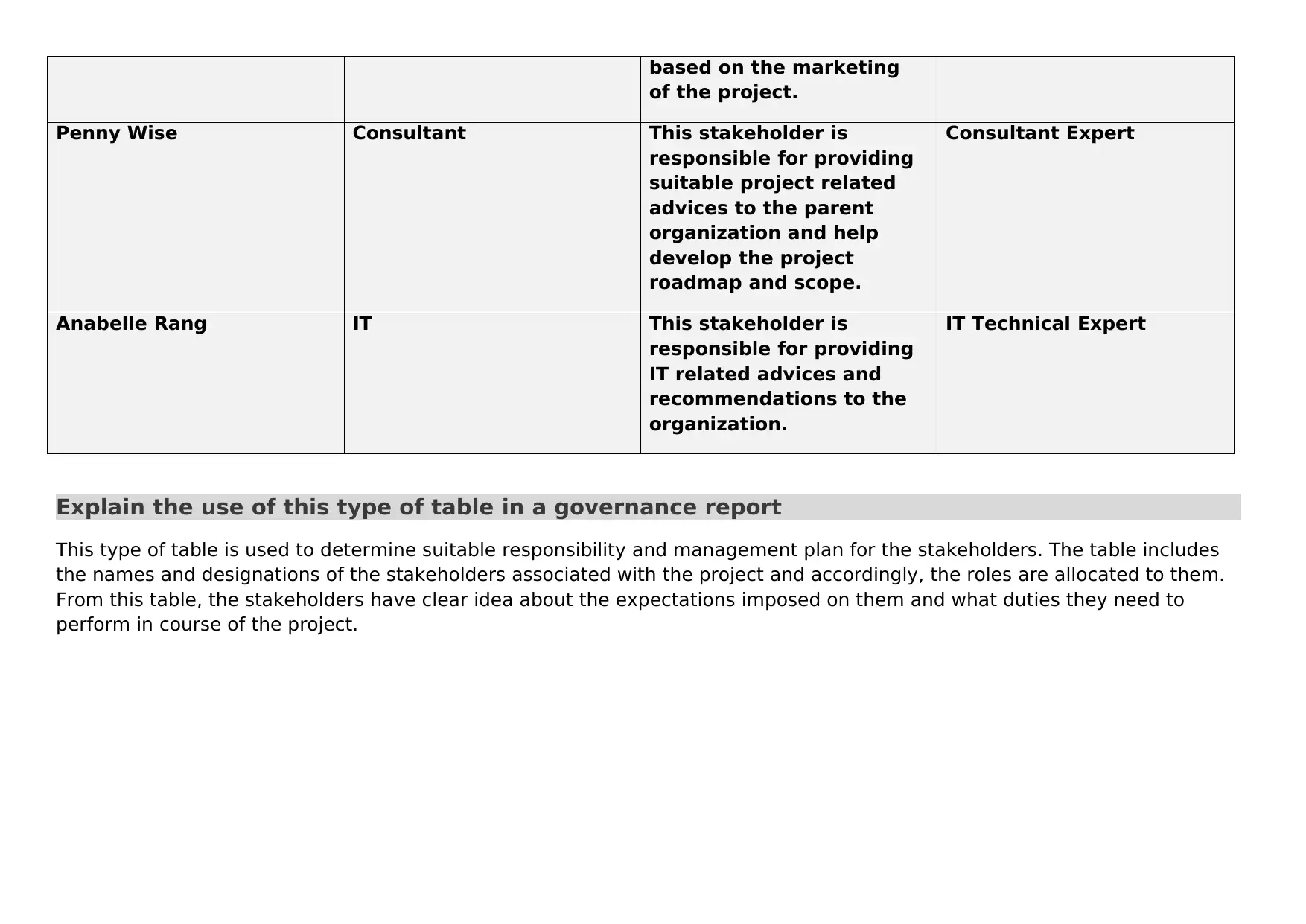
based on the marketing
of the project.
Penny Wise Consultant This stakeholder is
responsible for providing
suitable project related
advices to the parent
organization and help
develop the project
roadmap and scope.
Consultant Expert
Anabelle Rang IT This stakeholder is
responsible for providing
IT related advices and
recommendations to the
organization.
IT Technical Expert
Explain the use of this type of table in a governance report
This type of table is used to determine suitable responsibility and management plan for the stakeholders. The table includes
the names and designations of the stakeholders associated with the project and accordingly, the roles are allocated to them.
From this table, the stakeholders have clear idea about the expectations imposed on them and what duties they need to
perform in course of the project.
of the project.
Penny Wise Consultant This stakeholder is
responsible for providing
suitable project related
advices to the parent
organization and help
develop the project
roadmap and scope.
Consultant Expert
Anabelle Rang IT This stakeholder is
responsible for providing
IT related advices and
recommendations to the
organization.
IT Technical Expert
Explain the use of this type of table in a governance report
This type of table is used to determine suitable responsibility and management plan for the stakeholders. The table includes
the names and designations of the stakeholders associated with the project and accordingly, the roles are allocated to them.
From this table, the stakeholders have clear idea about the expectations imposed on them and what duties they need to
perform in course of the project.
Paraphrase This Document
Need a fresh take? Get an instant paraphrase of this document with our AI Paraphraser
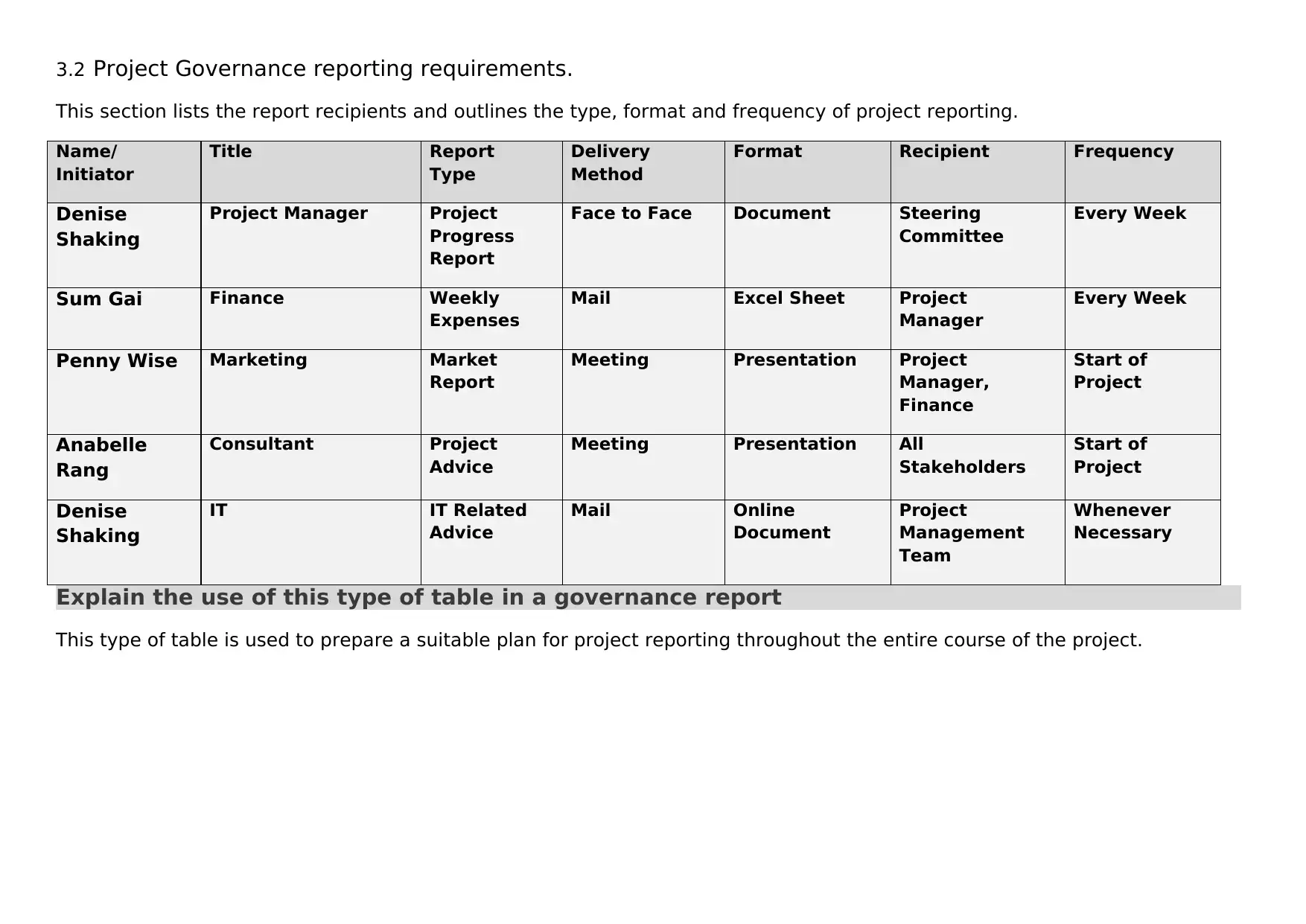
3.2 Project Governance reporting requirements.
This section lists the report recipients and outlines the type, format and frequency of project reporting.
Name/
Initiator
Title Report
Type
Delivery
Method
Format Recipient Frequency
Denise
Shaking
Project Manager Project
Progress
Report
Face to Face Document Steering
Committee
Every Week
Sum Gai Finance Weekly
Expenses
Mail Excel Sheet Project
Manager
Every Week
Penny Wise Marketing Market
Report
Meeting Presentation Project
Manager,
Finance
Start of
Project
Anabelle
Rang
Consultant Project
Advice
Meeting Presentation All
Stakeholders
Start of
Project
Denise
Shaking
IT IT Related
Advice
Mail Online
Document
Project
Management
Team
Whenever
Necessary
Explain the use of this type of table in a governance report
This type of table is used to prepare a suitable plan for project reporting throughout the entire course of the project.
This section lists the report recipients and outlines the type, format and frequency of project reporting.
Name/
Initiator
Title Report
Type
Delivery
Method
Format Recipient Frequency
Denise
Shaking
Project Manager Project
Progress
Report
Face to Face Document Steering
Committee
Every Week
Sum Gai Finance Weekly
Expenses
Mail Excel Sheet Project
Manager
Every Week
Penny Wise Marketing Market
Report
Meeting Presentation Project
Manager,
Finance
Start of
Project
Anabelle
Rang
Consultant Project
Advice
Meeting Presentation All
Stakeholders
Start of
Project
Denise
Shaking
IT IT Related
Advice
Mail Online
Document
Project
Management
Team
Whenever
Necessary
Explain the use of this type of table in a governance report
This type of table is used to prepare a suitable plan for project reporting throughout the entire course of the project.
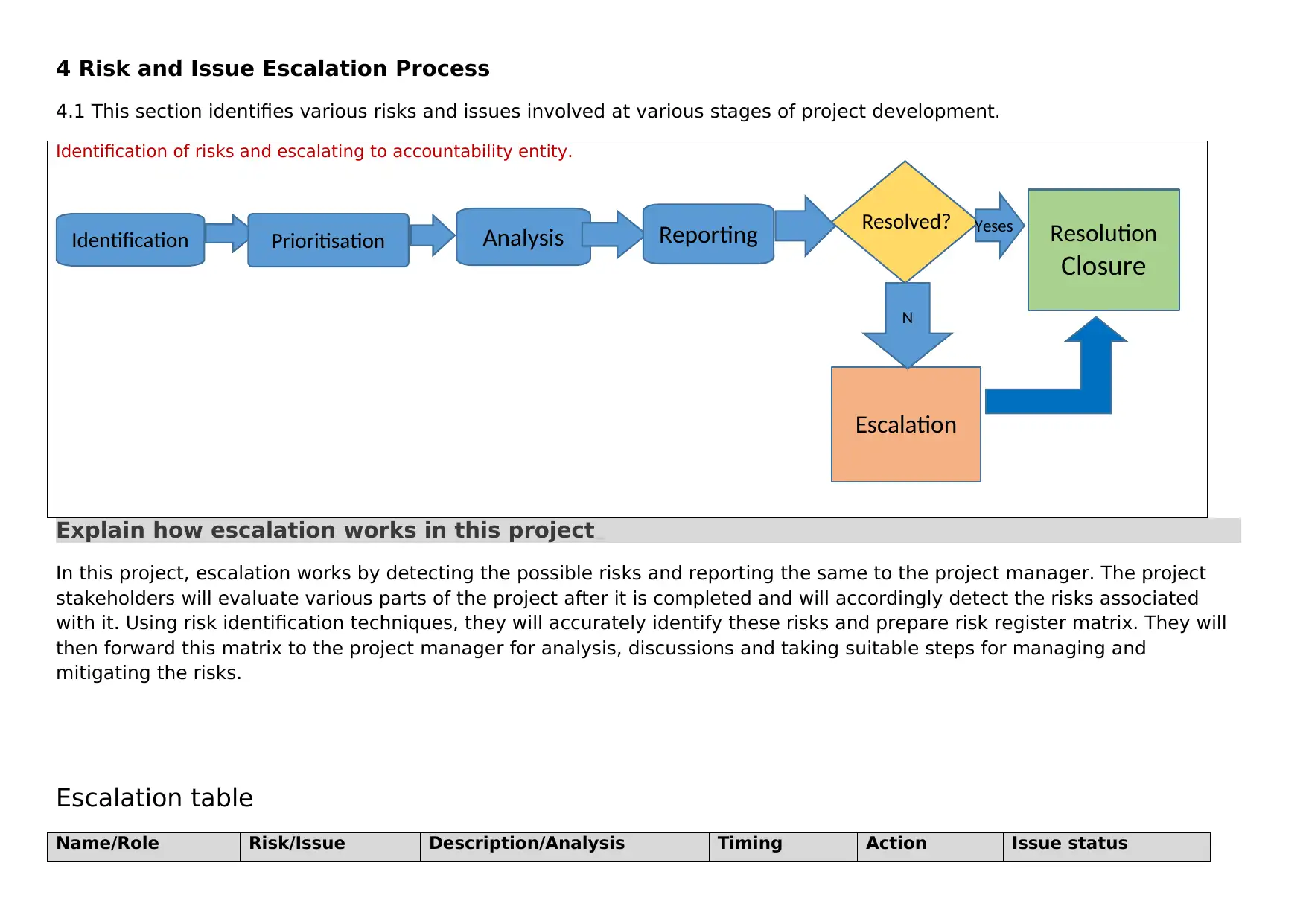
Identification Prioritisation Analysis Reporting
Escalation
N
Yeses Resolution
Closure
4 Risk and Issue Escalation Process
4.1 This section identifies various risks and issues involved at various stages of project development.
Identification of risks and escalating to accountability entity.
Explain how escalation works in this projectExplain the.
In this project, escalation works by detecting the possible risks and reporting the same to the project manager. The project
stakeholders will evaluate various parts of the project after it is completed and will accordingly detect the risks associated
with it. Using risk identification techniques, they will accurately identify these risks and prepare risk register matrix. They will
then forward this matrix to the project manager for analysis, discussions and taking suitable steps for managing and
mitigating the risks.
Escalation table
Name/Role Risk/Issue Description/Analysis Timing Action Issue status
Resolved?
Escalation
N
Yeses Resolution
Closure
4 Risk and Issue Escalation Process
4.1 This section identifies various risks and issues involved at various stages of project development.
Identification of risks and escalating to accountability entity.
Explain how escalation works in this projectExplain the.
In this project, escalation works by detecting the possible risks and reporting the same to the project manager. The project
stakeholders will evaluate various parts of the project after it is completed and will accordingly detect the risks associated
with it. Using risk identification techniques, they will accurately identify these risks and prepare risk register matrix. They will
then forward this matrix to the project manager for analysis, discussions and taking suitable steps for managing and
mitigating the risks.
Escalation table
Name/Role Risk/Issue Description/Analysis Timing Action Issue status
Resolved?
⊘ This is a preview!⊘
Do you want full access?
Subscribe today to unlock all pages.

Trusted by 1+ million students worldwide
1 out of 19
Related Documents
Your All-in-One AI-Powered Toolkit for Academic Success.
+13062052269
info@desklib.com
Available 24*7 on WhatsApp / Email
![[object Object]](/_next/static/media/star-bottom.7253800d.svg)
Unlock your academic potential
Copyright © 2020–2025 A2Z Services. All Rights Reserved. Developed and managed by ZUCOL.




